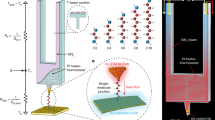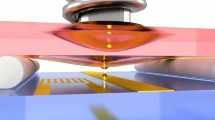Abstract
Atomic and single-molecule junctions represent the ultimate limit to the miniaturization of electrical circuits1. They are also ideal platforms for testing quantum transport theories that are required to describe charge and energy transfer in novel functional nanometre-scale devices. Recent work has successfully probed electric and thermoelectric phenomena2,3,4,5,6,7,8 in atomic-scale junctions. However, heat dissipation and transport in atomic-scale devices remain poorly characterized owing to experimental challenges. Here we use custom-fabricated scanning probes with integrated nanoscale thermocouples to investigate heat dissipation in the electrodes of single-molecule (‘molecular’) junctions. We find that if the junctions have transmission characteristics that are strongly energy dependent, this heat dissipation is asymmetric—that is, unequal between the electrodes—and also dependent on both the bias polarity and the identity of the majority charge carriers (electrons versus holes). In contrast, junctions consisting of only a few gold atoms (‘atomic junctions’) whose transmission characteristics show weak energy dependence do not exhibit appreciable asymmetry. Our results unambiguously relate the electronic transmission characteristics of atomic-scale junctions to their heat dissipation properties, establishing a framework for understanding heat dissipation in a range of mesoscopic systems where transport is elastic—that is, without exchange of energy in the contact region. We anticipate that the techniques established here will enable the study of Peltier effects at the atomic scale, a field that has been barely explored experimentally despite interesting theoretical predictions9,10,11. Furthermore, the experimental advances described here are also expected to enable the study of heat transport in atomic and molecular junctions—an important and challenging scientific and technological goal that has remained elusive12,13.
This is a preview of subscription content, access via your institution
Access options
Subscribe to this journal
Receive 51 print issues and online access
$199.00 per year
only $3.90 per issue
Buy this article
- Purchase on Springer Link
- Instant access to full article PDF
Prices may be subject to local taxes which are calculated during checkout




Similar content being viewed by others
References
Cuevas, J. C. & Scheer, E. Molecular Electronics: An Introduction to Theory and Experiment (World Scientific, 2010)
Scheer, E. et al. The signature of chemical valence in the electrical conduction through a single-atom contact. Nature 394, 154–157 (1998)
Song, H. et al. Observation of molecular orbital gating. Nature 462, 1039–1043 (2009)
Venkataraman, L., Klare, J. E., Nuckolls, C., Hybertsen, M. S. & Steigerwald, M. L. Dependence of single-molecule junction conductance on molecular conformation. Nature 442, 904–907 (2006)
Xu, B. Q. & Tao, N. J. Measurement of single-molecule resistance by repeated formation of molecular junctions. Science 301, 1221–1223 (2003)
Ludoph, B. & van Ruitenbeek, J. M. Thermopower of atomic-size metallic contacts. Phys. Rev. B 59, 12290–12293 (1999)
Reddy, P., Jang, S. Y., Segalman, R. A. & Majumdar, A. Thermoelectricity in molecular junctions. Science 315, 1568–1571 (2007)
Widawsky, J. R., Darancet, P., Neaton, J. B. & Venkataraman, L. Simultaneous determination of conductance and thermopower of single molecule junctions. Nano Lett. 12, 354–358 (2012)
Galperin, M., Saito, K., Balatsky, A. V. & Nitzan, A. Cooling mechanisms in molecular conduction junctions. Phys. Rev. B 80, 115427 (2009)
Dubi, Y. & Di Ventra, M. Colloquium: Heat flow and thermoelectricity in atomic and molecular junctions. Rev. Mod. Phys. 83, 131–155 (2011)
Karlström, O., Linke, H., Karlström, G. & Wacker, A. Increasing thermoelectric performance using coherent transport. Phys. Rev. B 84, 113415 (2011)
Lepri, S., Livi, R. & Politi, A. Thermal conduction in classical low-dimensional lattices. Phys. Rep. 377, 1–80 (2003)
Li, N. B. et al. Colloquium: Phononics: Manipulating heat flow with electronic analogs and beyond. Rev. Mod. Phys. 84, 1045–1066 (2012)
Agraït, N., Untiedt, C., Rubio-Bollinger, G. & Vieira, S. Onset of energy dissipation in ballistic atomic wires. Phys. Rev. Lett. 88, 216803 (2002)
Kim, Y., Pietsch, T., Erbe, A., Belzig, W. & Scheer, E. Benzenedithiol: a broad-range single-channel molecular conductor. Nano Lett. 11, 3734–3738 (2011)
Huang, Z. F. et al. Local ionic and electron heating in single-molecule junctions. Nature Nanotechnol. 2, 698–703 (2007)
Ward, D. R., Corley, D. A., Tour, J. M. & Natelson, D. Vibrational and electronic heating in nanoscale junctions. Nature Nanotechnol. 6, 33–38 (2011)
Ioffe, Z. et al. Detection of heating in current-carrying molecular junctions by Raman scattering. Nature Nanotechnol. 3, 727–732 (2008)
Datta, S. Electronic Transport in Mesoscopic Systems (Cambridge Univ. Press, 1995)
Lee, W. & Reddy, P. Creation of stable molecular junctions with a custom-designed scanning tunneling microscope. Nanotechnology 22, 485703 (2011)
Kiguchi, M., Miura, S., Hara, K., Sawamura, M. & Murakoshi, K. Conductance of a single molecule anchored by an isocyanide substituent to gold electrodes. Appl. Phys. Lett. 89, 213104 (2006)
Sivan, U. & Imry, Y. Multichannel Landauer formula for thermoelectric transport with application to thermopower near the mobility edge. Phys. Rev. B 33, 551–558 (1986)
Paulsson, M. & Datta, S. Thermoelectric effect in molecular electronics. Phys. Rev. B 67, 241403 (2003)
Pauly, F. et al. Cluster-based density-functional approach to quantum transport through molecular and atomic contacts. New J. Phys. 10, 125019 (2008)
Xue, Y. Q. & Ratner, M. A. End group effect on electrical transport through individual molecules: a microscopic study. Phys. Rev. B 69, 085403 (2004)
Malen, J. A. et al. Identifying the length dependence of orbital alignment and contact coupling in molecular heterojunctions. Nano Lett. 9, 1164–1169 (2009)
Venkataraman, L. et al. Single-molecule circuits with well-defined molecular conductance. Nano Lett. 6, 458–462 (2006)
Brandbyge, M. et al. Quantized conductance in atom-sized wires between two metals. Phys. Rev. B 52, 8499–8514 (1995)
Nielsen, S. K. et al. Current-voltage curves of atomic-sized transition metal contacts: an explanation of why Au is ohmic and Pt is not. Phys. Rev. Lett. 89, 066804 (2002)
Tsutsui, M., Kawai, T. & Taniguchi, M. Unsymmetrical hot electron heating in quasi-ballistic nanocontacts. Sci. Rep. 2, 217 (2012)
Acknowledgements
P.R. acknowledges support from the US Department of Energy, Office of Basic Energy Sciences, Division of Materials Sciences and Engineering under award no. DE-SC0004871 (nanofabrication of novel scanning probes), from the National Science Foundation under award no. CBET 0844902 (instrumentation for real-time control) and from the Center for Solar and Thermal Energy conversion, an Energy Frontier Research Center funded by the US Department of Energy, Office of Science, Basic Energy Sciences under award no. DE-SC0000957 (development of a scanning probe microscope). L.A.Z. acknowledges financial support from the Spanish MICINN through grant no. FIS2010-21883. F.P. acknowledges funding through the Carl Zeiss Stiftung, the DFG SFB 767, and the Baden-Württemberg Stiftung. P.R. thanks E. Meyhofer for discussions and comments. P.R. and J.C.C. thank A. Nitzan for discussions. J.C.C. is grateful for the hospitality provided by the Institute for Advanced Studies of the Hebrew University of Jerusalem, where part of this work was carried out.
Author information
Authors and Affiliations
Contributions
The idea for the experiments was conceived by P.R. and J.C.C. The experiments were performed by W.L. and K.K. The custom-fabricated probes were designed, fabricated and characterized by K.K. and W.J. Ab initio charge transport calculations were performed by L.A.Z. and F.P. The manuscript was written by P.R. and J.C.C. with comments and inputs from all authors.
Corresponding authors
Ethics declarations
Competing interests
The authors declare no competing financial interests.
Supplementary information
Supplementary Information
This file contains Supplementary Figures 1-14, Supplementary Discussion and Supplementary References. (PDF 4309 kb)
Rights and permissions
About this article
Cite this article
Lee, W., Kim, K., Jeong, W. et al. Heat dissipation in atomic-scale junctions. Nature 498, 209–212 (2013). https://doi.org/10.1038/nature12183
Received:
Accepted:
Published:
Issue Date:
DOI: https://doi.org/10.1038/nature12183
This article is cited by
-
A Comprehensive Review for Micro/Nanoscale Thermal Mapping Technology Based on Scanning Thermal Microscopy
Journal of Thermal Science (2022)
-
Hexagonal boron nitride as the foaming agent to improve the flexibility of polyimide-derived graphite films with high thermal conductivity
Applied Physics A (2022)
-
Near-field photonic cooling through control of the chemical potential of photons
Nature (2019)
-
Side-group chemical gating via reversible optical and electric control in a single molecule transistor
Nature Communications (2019)
-
Heat dissipation in quasi-ballistic single-atom contacts at room temperature
Scientific Reports (2019)
Comments
By submitting a comment you agree to abide by our Terms and Community Guidelines. If you find something abusive or that does not comply with our terms or guidelines please flag it as inappropriate.



